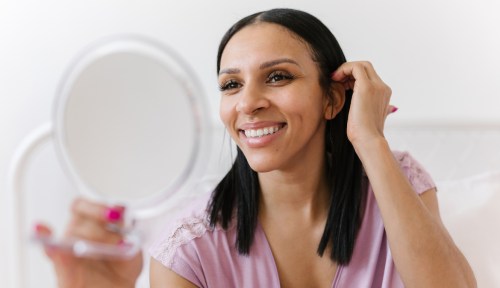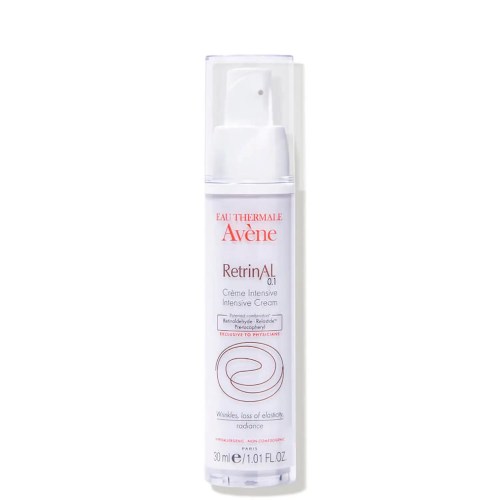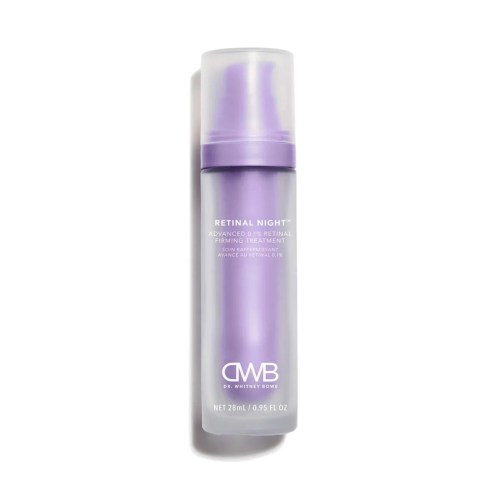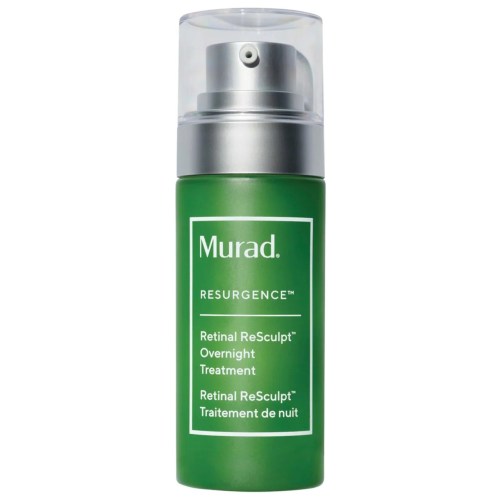Our editors independently select these products. Making a purchase through our links may earn Well+Good a commission
‘Retinal’ Works Faster and Better Than Retinol—So Why Isn’t It in Your Routine Yet?
Learn the benefits of retinal from dermatologists, who say it goes above and beyond retinol in terms of clearing acne and smoothing skin.

If you were to ask leading skin-care experts to choose the one holy grail product they recommend most, chances are you’d see retinoids pop up time and time again. After all, these vitamin-A derivatives are routinely mentioned as the gold standard for improving a range of skin concerns including acne, hyperpigmentation, fine lines, and wrinkles—and a massive body of research backs up these benefits. (Overachiever, much?)
Experts in This Article
board-certified dermatologist at Skin Wellness in Birmingham, Alabama
board-certified dermatologist at Medical Dermatology and Cosmetic Surgery in New York
esthetician and founder of Renée Rouleau Skincare
board-certified dermatologist based in New York
There is a range of potencies across the retinoid spectrum, from the over-the-counter retinols you can snag at Sephora to the Rx-strength stuff you’ll need a doctor to prescribe. And recently, a version of the stuff that falls squarely between the two has been cropping up in formulations: retinaldehyde, aka retinal.
What is retinal?
Retinal is one of several types of retinoids on offer, each of which varies by strength. “Before retinoids work, they need to be converted to retinoic acid,” says Corey L. Hartman, MD, FAAD, a board-certified dermatologist at Skin Wellness in Birmingham, Alabama. (For reference, retinoic acid is commonly known by the brand name Retin-A… as if there weren’t already too many similar terms to keep track of). “Retinaldehyde is one step below retinoic acid, so it requires fewer conversion steps and ultimately is more powerful [than retinol],” he continues.
Retinal vs retinol
Retinol “has to be converted first to retinal before being converted to retinoic acid, making it notoriously unstable,” says Renée Rouleau, celebrity esthetician and founder of her namesake skin-care line. “Retinal also has a very small molecular size compared to other types of retinoids,” she adds, which makes it easier to penetrate the skin and work its magic. (Still, retinoic acid is smaller, which allows the skin to accept it even more readily, Rouleau notes).
“Retinal can be considered more potent than your traditional retinol and a little bit more gentle than your prescription Retin-A,” says Marisa Garshick, MD, a board-certified dermatologist in New York City. “So it’s a good in-between.”
When using retinal, you’ll often see a percentage of 0.1 on the label, which may appear low if you’re used to looking at retinol concentrations. “People are used to seeing percentages in terms of retinol,” says Whitney Bowe, MD, a board-certified dermatologist in New York City and creator of DWB Beauty Retinal Night Cream. “With retinol, you have percentages of 0.3, 0.5, 1.0—retinal is a completely different beast. It’s more than 10 times more powerful than retinol—0.1 percent retinal is way stronger than 1.0 percent retinol.”
Simply put, retinal puts you in the fast lane to address common complexion concerns and is the most potent retinoid you can get without a prescription.
The benefits of using retinal
“Similar to retinol, retinal helps promote cell turnover to even skin tone and texture, smooth wrinkles and fine lines, and prevent acne,” says Dr. Hartman.s. But the benefits don’t end there.
A 2018 randomized controlled trial also found that retinal creams improved overall photoaging, reduced transepidermal water loss (TEWL), and increased hydration with twice-daily use over three months in female Korean participants. Moreover, an older study found that “retinaldehyde has beneficial effects on the vascular component of rosacea,” and more recent research in animals backs up its “significant depigmenting activity.”
If you have one or several of these concerns, a single retinal product can supercharge progress on your skin-care goals, packing a more powerful punch than other OTC options. “Retinal is stronger than retinol,” Dr. Hartman reiterates, “and the benefits are greater and faster than traditional retinols.” So long as your skin can tolerate its powerful effects, of course.

Retinal side effects
Retinol is infamous for causing the so-called “retinol uglies“—aka dryness, peeling, and purging before the skin-enhancing benefits you actually want kick in. Retinal can cause the same side effects, but they can be even stronger since the ingredient is more potent. For that reason, if you’re new to topical vitamin A, diving into retinal from the get-go may not be the best choice.
“Since retinals are stronger than retinol, they should not be used by those who are retinol naïve,” says Dr. Hartman. “But if you’ve acclimated to the class, then it would be an appropriate step up and just shy of the strength of a prescription product.”
Rouleau shares that consistency is key to yielding the most significant benefits. Even if you use retinol every day and decide to experiment with a new retinal product, start slow and steady to allow your skin to acclimate to the new ingredient and minimize the risk of irritation. “I recommend using it in a ‘two nights on, one night off’ pattern throughout the week, for a total of four nights a week,” she says “On opposite nights, use an exfoliating acid serum to accelerate the removal of dull skin cells,” which she says will promote enhanced absorption of retinal. You can also follow the retinol sandwich method, putting on a layer of moisturizer before and after you apply the retinal.
If your skin gets sensitized, further limit your use and-or consult your dermatologist to see if another product—vitamin A or otherwise—may be better for your skin’s needs. If your skin is tolerating it well, feel free to increase the number of nights you use it.
Why more brands are jumping on the retinal bandwagon
According to Rouleau, there are a few key reasons why retinal is up-and-coming in the skin-care world.
“The demand for vitamin-A ingredients is at an all-time high because of their benefits,” she says. “People are becoming more aware of retinoids and how they must be converted to retinoic acid within the skin in order to be usable by cells. The closer we can get to retinoic acid, the better.” In other words, thanks to a greater emphasis on skin-care education and ingredient deep dives—whether via social media, beauty editorials, or info from trusted derms—retinal’s star is clearly on the rise.
Rouleau also notes that retinal (and retinol, even more so) is historically unstable in products, which has made it challenging to formulate with. “However, more ingredient companies are now developing technologies to better stabilize retinal so that it can be more effective in formulations,” she explains. “Consumer demand is also helping push science further to meet what buyers are looking for,” which is fresher, clearer skin via products worthy of their hard-earned money.
Retinal FAQs
1) Is retinal as good as retinol?
Reintal is more potent than retinol, allowing you to see quicker, more impressive results.
2) Can I use retinal every day?
Yes, if your skin can handle it.
3) Is retinal stronger than tretinoin?
No, tretinoin, AKA Retin-A, is perception strength and is the most potent retinoid.
4) Does retinal help with sagging skin?
Retinal can help with sagging skin by stimulating collagen production that leads to firmer skin.
5) When should I start using retinal?
You should start using retinal in the spring or fall, when temperatures are relatively mild and your skin is better able to tolerate any potential irritation.
5 retinal skin-care products to try
Avène, Retrinal Intensive Cream — $79.00
Don’t be confused by yet another slight variation in this product’s name, as it does, in fact, feature retinal as an active ingredient. Better yet, it’s also rich in plumping peptides and soothing Avène thermal spring water, which help to make it safe enough for even super dry and sensitive skin. It also gets Dr. Hartman’s official stamp of approval, as he notes that this cream “delivers benefits without compromising the skin barrier or causing irritation.”
DWB Beauty, Retinal Night — $99.00
Although this retinal serum is 10 times more potent than retinol, it’s not 10 times more irritating. According to Dr. Bowe, it’s less irritating than many retinols out there thanks to built-in “surge protectors.” These include a proprietary pentalipid matrix that mimics your skin’s barrier with a blend of three ceramides, the amino acid phytosphingosine, and plant-based sterols to rehydrate and soothe skin while strengthening the moisture barrier. “You get all the benefits without the irritation,” says Dr. Bowe.
Youth to the People Retinal + Niacinamide Youth Serum — $72.00
This overnight serum contains 0.15 percent stabilized retinal to clarify the complexion and improve signs of aging and uneven texture; niacinamide (yet another multitasking all-star) to boost the brightening effects of retinal and promote skin barrier function; plus calming adaptogens and ceramides to stave off sensitivity.
Allies of Skin Retinal & Peptides Repair Night Cream — $121.00
A leader in “cleanical” skin-care, Allies of Skin offers its own patented form of encapsulated retinal to minimize the appearance of fine lines and wrinkles in this overnight mask. All the while, a 13.5 percent peptide complex reinforces the skin’s moisture barrier as antioxidant-rich organic oils recharge and replenish dull, thirsty skin for a fresher complexion by morning.
Murad, Retinal ReSculpt Overnight Treatment — $105.00
This serum targets mild-to-moderate aging signs, with a focus on neck and jowl sagging, deep-set wrinkles, crepey skin, and loss of elasticity. Well+Good contributor Marie Lodi found that it worked wonders on her décollatege. “I don’t really have deep set wrinkles or sagging of the jowls, but I do have some pretty intense lines in my décollatege, which are most likely caused by side sleeping,” writes Lodi. “In just a couple of weeks, I noticed that the skin on my chest was softer and less red. But the biggest difference was the decrease in lines. My décollatege almost looked like it did in my late ‘20s. It was smoother, tighter, and it was shocking, to say the least.”
Sign up for the Well+Good SHOP Newsletter
Get exclusive deals on wellness, beauty, fitness, and food products that have been hand-picked by our editors.
Got it, you've been added to our email list.















